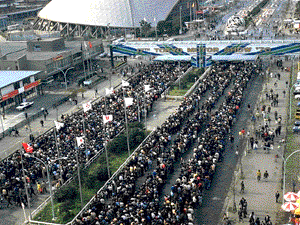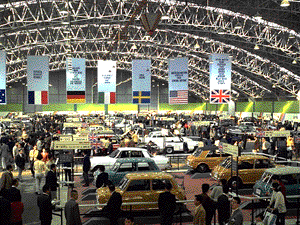 |
 |
 |
The
17th Tokyo Motor Show (1970
. 10/30 - 11/12)
 |
 |
| The 17th Tokyo Motor Show Poster |
Foreign cars, which had participated only in the 11th
and 12th shows, joined this show. There were: 33 American
cars by 4 makers, 18 English cars by11 makers, 25 German
cars by 8 makers, 5 French cars by 3 makers, 8 Italian
cars by 4 makers, 4 Swedish cars by 2 makers, and 2 Australian
cars by 1 maker for a total of 95 cars by 33 makers from
7 countries. Obviously competition was severe in Hall
3. Although those stands were very crowded, the visitors
seemed to observe the cars calmly. The "foreign car worship"
fever was not as strong as anticipated, partly due to
the improvement of technological standards in domestic
cars.
The domestic cars, on the other hand, were worth seeing.
Prominent was a display of creative technology for which
all the automakers competed. A variety of cars were displayed:
Leisure cars, city cars, sporty models, and experimental
cars designed for safety or non-pollution. Conspicuous
new models were the Celica 1600GT, promoted by Toyota
as "Born to be a hardtop coupe," the Mitsubishi Galant
GTO-MR, and the Skyline 2000GTR. They were all prepared
for the high speed age with newly developed double overhead
cam engines. In addition to these, Toyota announced a
new mass-market car, the Carina, while Nissan launched
the Cherry equipped with an FF transverse engine and all
independent suspension. |
 |
 |
 |
Midget vehicles with high horse power in sporty versions influenced by the high speed age were lined up. Honda ZGT (36hp), Suzuki Fronte 71SSS, Mitsubishi Minica GS (38hp), Daihatsu Fellow MAXSS (40hp), and Subaru R-2SS (36hp) attracted attention from young people.
Noticeable at this show was the reinforced JMIF attitude toward safety and pollution problems. The Safety Science Center s name was changed to the "Safety and Anti-Pollution Center."
The slogan "Better tomorrow for man and car" was displayed throughout the showplace. Each automaker cooperated by displaying non-polluting engines under development, fuel injection systems, and electric vehicles.
Test cars made public were: A Toyota electric car based on the Commuter, a Nissan electric car with a 120V-60AH battery, a Toyo Kogyo (now Mazda) hybridelectric car with a combination motor and a small rotary engine, a Mitsubishi electric car and a Daihatsu hybrid car. Nissan, Mitsubishi, Isuzu, Honda, and Fuji Heavy Industries also displayed electronic injection systems, and Nissan and Mitsubishi publicized gas turbine engines. Mitsubishi Heavy Industries automobile division split off that June to become Mitsubishi Motors Corporation, in which Chrysler participated the following year.
The number of visitors to this show, 1,452,900, decreased somewhat from the previous show. This was partly because parking was prohibited around the show site to avoid traffic congestion in Tokyo.
|
 |
|
|
|